You are using an out of date browser. It may not display this or other websites correctly.
You should upgrade or use an alternative browser.
You should upgrade or use an alternative browser.
Weird, Rare, Forgotten & Discontinued Food Products
- Thread starter Swifty
- Start date
Herr Cloaca
Abominable Snowman
- Joined
- Dec 26, 2020
- Messages
- 698
Watership Down Under
brownmane
off kilter
- Joined
- Feb 1, 2019
- Messages
- 4,748
- Location
- Ontario, Canada
Canned rabbit, once a dinnertime delicacy, now consigned to the burrows of history
 I initially read "caned".
I initially read "caned".Herr Cloaca
Abominable Snowman
- Joined
- Dec 26, 2020
- Messages
- 698
Circa 25 years ago, there was some kind of fat free "ice cream" I used to get in Tesco. Plastic tubs, three flavours: strawberry, chocolate and vanilla. Then it disappeared.
Steven
Glorified cat flunky
- Joined
- Nov 5, 2023
- Messages
- 1,175
- Location
- UK
Asda sell a reasonably low-fat ice cream in various flavours, named Halo Top:
https://groceries.asda.com/product/...-top-sea-salt-caramel-ice-cream/1000097586344
https://groceries.asda.com/product/...-top-sea-salt-caramel-ice-cream/1000097586344
AnonyJ
Captainess Sensible
- Joined
- Nov 1, 2015
- Messages
- 1,961
- Location
- Having-a-nice-cup-of-tea-and-a-sit-down-shire
Gorgeous, beautiful and heavenly Tutti-Frutti ice cream is now a rarer sight than my previously-referred-to Christmas tinsel bikini :-(
Occasionally it pops up in a shop selling posh ice cream cornets but the days of being able to actually buy a tub of it and take it home have gone!

Occasionally it pops up in a shop selling posh ice cream cornets but the days of being able to actually buy a tub of it and take it home have gone!
Last edited:
Ascalon
Justified & Ancient
- Joined
- Jul 3, 2009
- Messages
- 1,351
It may well have been in the brief window when Olestra was in foodstuffs, here.Asda sell a reasonably low-fat ice cream in various flavours, named Halo Top:
https://groceries.asda.com/product/...-top-sea-salt-caramel-ice-cream/1000097586344
brownmane
off kilter
- Joined
- Feb 1, 2019
- Messages
- 4,748
- Location
- Ontario, Canada
Olestra...that really slipped awayIt may well have been in the brief window when Olestra was in foodstuffs, here.
 into oblivion..
into oblivion..Ascalon
Justified & Ancient
- Joined
- Jul 3, 2009
- Messages
- 1,351
I see what you did, there!Olestra...that really slipped awayinto oblivion..
Analogue Boy
Bar 6
- Joined
- Aug 10, 2005
- Messages
- 13,651
Check out those ingredients. I’d be surprised if there was any real ice in the process.Asda sell a reasonably low-fat ice cream in various flavours, named Halo Top:
https://groceries.asda.com/product/...-top-sea-salt-caramel-ice-cream/1000097586344
kesavaross
Justified & Ancient
- Joined
- Oct 18, 2015
- Messages
- 2,038
- Location
- Brighton, UK
I don't know how people can eat such highly processed foods ladened with chemicals?Check out those ingredients. I’d be surprised if there was any real ice in the process.
I read an article a while back that stated that a lot of foods, especially sweets, stopped being produced during the 70's when the newly emerging chemical food additives during the 60's really got a foothold but then later research showed how toxic some of these chemical were.
Tempest63
Justified & Ancient
- Joined
- Dec 19, 2009
- Messages
- 3,083
Carte D’Or used to supply Tesco and Sainsbury’s with a Sicilian Lemon Sorbet. The ice was loaded with the finest shavings of lemon peel. It was without doubt my all time favourite. Alas, it is now three or four years since we have seen it in stores.Circa 25 years ago, there was some kind of fat free "ice cream" I used to get in Tesco. Plastic tubs, three flavours: strawberry, chocolate and vanilla. Then it disappeared.
Last edited:
Ermintruder
The greatest risk is to risk nothing at all...
- Joined
- Jul 13, 2013
- Messages
- 6,209
This remains a strangely-variable area of food technology, beset by pseudo-subjective regional differences (cf North American corn syrup sweetners that are deemed unacceptable in Europe).but then later research showed how toxic some of these chemical were
They are also bizarrely subject to reinterpretation over time: a perfect example of this was the UK's banning of cyclamate sweetners in the 1960s (which I can personally remember had a weirdly buzzing/sickening sweetness that reminded me of BPC chloroform)...apparently that was allowed back 'out of captivity' in 1996, which really disturbs me.
The human taste preference for sweetness has been an archetypal problem for us addicted primates.
Lead salts, deep caramelisation, concentrated fructoses just do not do us any good at all. But we tend to adore the damn taste, at a level deeper than the mere specieal (bugs, microbes, plants, all animalia)... it is even, arguably, a multicellular tropismic driver in terms of osmotic transportive movement in plants.
There's lots more research to be done on this: and plenty of unwelcome shocks awaiting the researchers (cancer tumours adore sugar as an illegitimately-empowering source of energy....neurodegenerative conditions such as Alzheimers and many dementias may have root causes in what can be thought of as being Type 3 diabetes)
Last edited:
Analogue Boy
Bar 6
- Joined
- Aug 10, 2005
- Messages
- 13,651
I gave up sugar a few years ago and find it strange that many ready made meals are so sweet, they almost taste like desserts these days.
Eyespy
Abominable Snowman
- Joined
- Oct 6, 2010
- Messages
- 582
We have a well in the garden, more or less dry and generally coverdby a slab. A few years back one of the sons and a friend decided to clim b own ( it’s about 5 ft down) and came back up with a haul of crisp and sweet wrappers from the “olden days” of 1960’s. They were thrilled and we spent ages discussing tatty crisp packets.Norfolk beach walker finds crisp packet from 1960s.
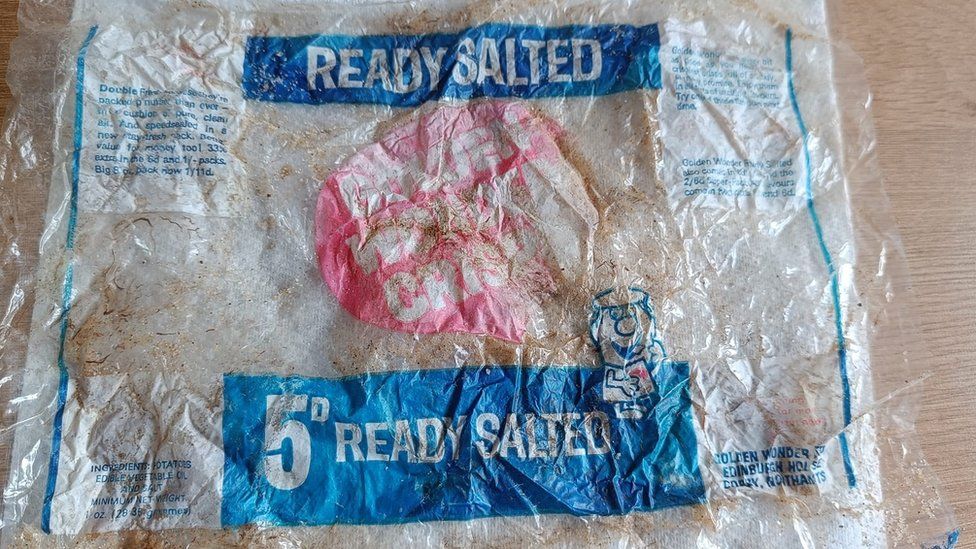
The Golden Wonder crisp packet is almost certainly from the late 1960s
Crisp packets and sweet wrappers dating back as far as the 1960s have been found on a Norfolk beach.
Chris Turner, from Clifton, Bedfordshire, came across the decades-old litter while staying at his holiday home at Scratby, near Great Yarmouth.
They include pre-decimalisation packets of Golden Wonder crisps, marked with a price of 5d, and 2d Spangles sweets.
"I think the recent high tides at Hemsby have shifted everything to the surface," said Mr Turner.
"It's only about a mile away, so the plastic could have come from there.
"I couldn't believe how old they were; I'm not a big eco-warrior but I think the plastic in the seas is dreadful and the amount of litter generally along the beach is awful.
"I was always told not to drop litter."
Plastic kills fish and other sea creatures and takes hundreds of years to break down into less harmful materials.
It is estimated there are 171 trillion pieces of plastic in the world's oceans.
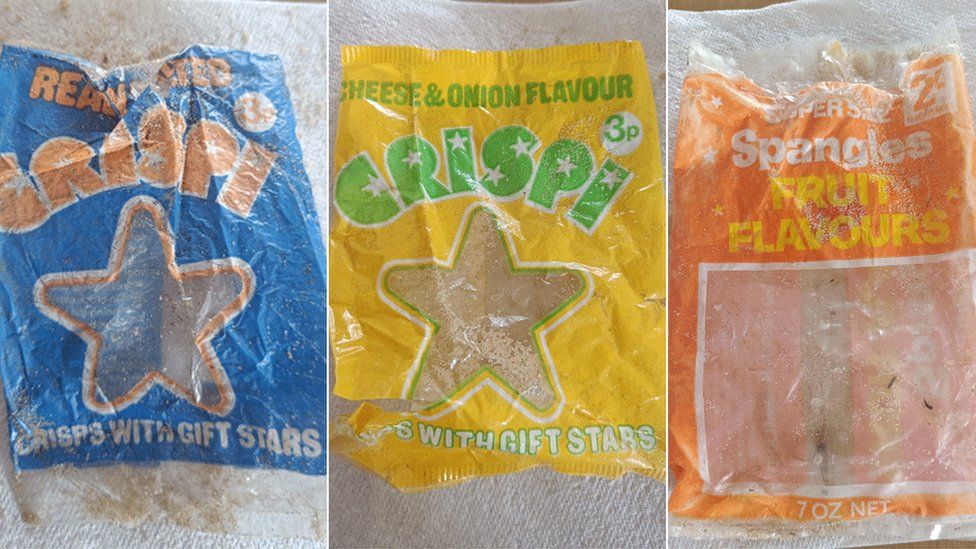
Mr Turner could not find any information on Crispi while confectionery giant Mars has been asked by the BBC to try to date this packet of Spangles
All the packets were found in Norfolk were in remarkable condition, with labelling and wording clearly visible, and were on top of the sand.
Mr Turner, who shared images of his finds on a local Facebook page, said it provided some nostalgia for snacks of yesteryear while providing evidence of just how long it takes for plastic to decompose.
"When I saw them I thought 'I'm picking that up' - just out of curiosity, really," added Mr Turner, who discovered them during three separate walks with his dog.
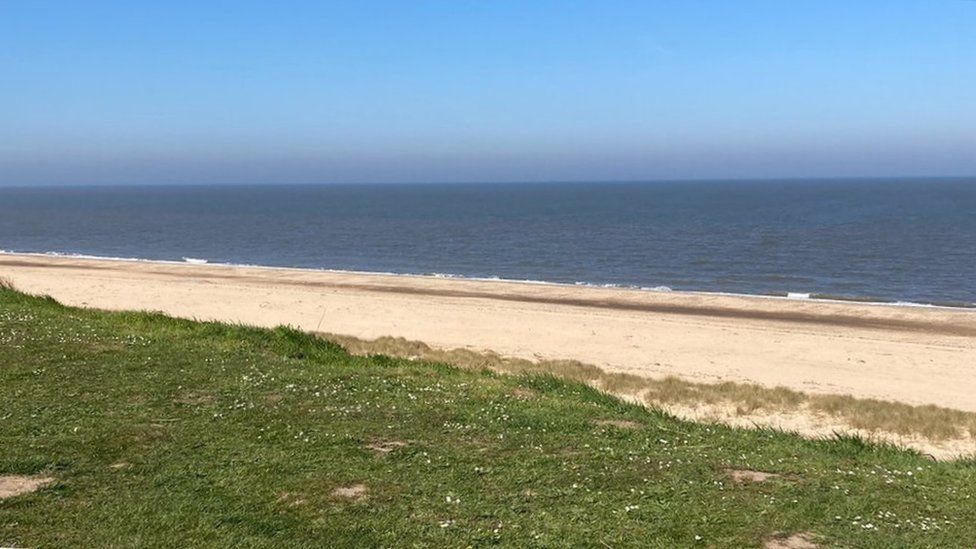
Mr Turner regular spends his weekends at Scratby in Norfolk
No use-by dates were visible, so Mr Turner searched online for some clues as to their age.
Tayto Group, which now owns Golden Wonder, confirmed the packet was almost certainly from the late 1960s and said it had made changes in recent years to reduce plastic packaging.
The Smiths Horror Bags bacon flavour corn and potato claws were available for about five years in the 1970s and were reportedly criticised at the time for being potentially disturbing for children.
Mystery surrounds the provenance of the two empty packets of Crispi and the fruit flavour Spangles could potentially date from the 1960s or early 70s.
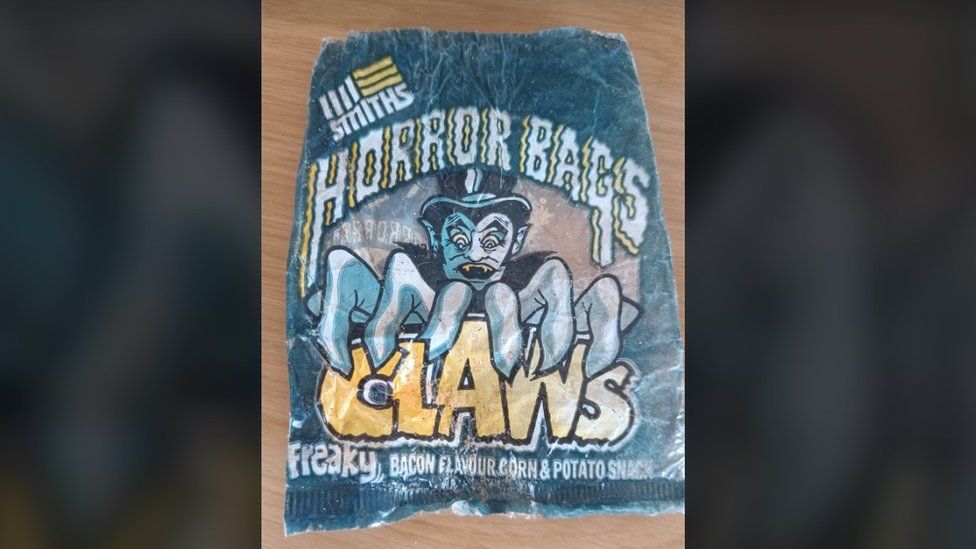
The empty Horror Bags packet could be finding its way on to an auction site
The chance finds could pay dividends for Mr Turner who will continue to keep an eye out for vintage litter on the beach.
"The last one I found - Horror Bags - I contacted a group online and was told 'actually, it's really valuable'," he said.
"I've had a look and some have gone for over £100 on eBay because they're collectable.
"So I know what I'll be doing with that very soon."
https://www.bbc.co.uk/news/uk-england-norfolk-65428452
Dinobot
Justified & Ancient
- Joined
- May 19, 2015
- Messages
- 4,451
- Location
- Broadcasting from the moon...
So does this forum.We have a well in the garden, more or less dry and generally coverdby a slab. A few years back one of the sons and a friend decided to clim b own ( it’s about 5 ft down) and came back up with a haul of crisp and sweet wrappers from the “olden days” of 1960’s. They were thrilled and we spent ages discussing tatty crisp packets.
Stormkhan
Disturbingly familiar
- Joined
- May 28, 2003
- Messages
- 8,703
I've not mentioned my collection of empty Corona drink bottles.
Mainly because I don't have one.
However, I miss that brand of chemical-laced sugar water. It tasted, well, softer to the palate than the acidic fizzy pop of the day.
Though, I will still gorge myself on Cherry cola.
Mainly because I don't have one.
However, I miss that brand of chemical-laced sugar water. It tasted, well, softer to the palate than the acidic fizzy pop of the day.
Though, I will still gorge myself on Cherry cola.
Mythopoeika
I am a meat popsicle
- Joined
- Sep 18, 2001
- Messages
- 51,825
- Location
- Inside a starship, watching puny humans from afar
The stuff I remember and quite liked was Cydrax. Hardly anybody sold it, so I only ever had 2 bottles of it and one lollipop from a van.
My Dad introduced me to it when we were visiting my nana in Wales.
Then they stopped selling it altogether in the late 80s. It's still available in Trinidad and Tobago, but not in its country of origin. They also have Peardrax, which Trinidadians regard as a 'fine drink'.
My Dad introduced me to it when we were visiting my nana in Wales.
Then they stopped selling it altogether in the late 80s. It's still available in Trinidad and Tobago, but not in its country of origin. They also have Peardrax, which Trinidadians regard as a 'fine drink'.
eburacum
Papo-furado
- Joined
- Aug 26, 2005
- Messages
- 5,868
More about Corona here. Comes from Wales, look you. I remember getting money back on the bottles (in old pennies - forget how many).
https://www.batterseabus.co.uk/the-corona-man-cometh/

https://www.batterseabus.co.uk/the-corona-man-cometh/

Analogue Boy
Bar 6
- Joined
- Aug 10, 2005
- Messages
- 13,651
Isn’t that the way they prepare tinned stuff in the first place?It is if you want to blow yourself up.
Stormkhan
Disturbingly familiar
- Joined
- May 28, 2003
- Messages
- 8,703
Round our way, the corner off-license that gave coinage for returned empties didn't realise that we could go to the wall and reach over to pull up Corona empties from the crates he stored there.More about Corona here. Comes from Wales, look you. I remember getting money back on the bottles (in old pennies - forget how many).
https://www.batterseabus.co.uk/the-corona-man-cometh/

A form of recycling even then in the seventies!
Analogue Boy
Bar 6
- Joined
- Aug 10, 2005
- Messages
- 13,651
As a kid in the sixties, we always took our pop bottles back.
1. You could get enough money back for Fruit Salad or Black Jack chews.
2. Bottles reused and therefore a green option.
3. Less broken glass on the areas you used to play on - especially important when dramatically expiring in a game of Best Man Falls.
1. You could get enough money back for Fruit Salad or Black Jack chews.
2. Bottles reused and therefore a green option.
3. Less broken glass on the areas you used to play on - especially important when dramatically expiring in a game of Best Man Falls.
Tempest63
Justified & Ancient
- Joined
- Dec 19, 2009
- Messages
- 3,083
I had a licorice toffee today and it made me hanker for the old Callard & Bowser licorice toffee fingers. They were a bit of an extravagance when I was a kid, aimed more at the adult market.
They used to come in a silver block and looked like the top drawer sweets that they were. I was a bit of a licorice freak back in the day and always had a little cardboard box of licorice imps in my pocket.
By the way I bought some own brand licorice allsorts from M&S a couple of weeks ago. Not a patch on Bassets Licorice Allsorts from my childhood.
They used to come in a silver block and looked like the top drawer sweets that they were. I was a bit of a licorice freak back in the day and always had a little cardboard box of licorice imps in my pocket.
By the way I bought some own brand licorice allsorts from M&S a couple of weeks ago. Not a patch on Bassets Licorice Allsorts from my childhood.
CharmerKamelion
NOT the Bishop of Bath and Wells
- Joined
- Feb 27, 2021
- Messages
- 1,511
- Location
- Lightyears from Zanzibar
I bought a bag of delicious liquorice toffees last week. Sooooooooo good. Lasted 3 days, which is good going for me. I'm definitely going back to that garden centre again soon!I had a licorice toffee today and it made me hanker for the old Callard & Bowser licorice toffee fingers. They were a bit of an extravagance when I was a kid, aimed more at the adult market.
They used to come in a silver block and looked like the top drawer sweets that they were. I was a bit of a licorice freak back in the day and always had a little cardboard box of licorice imps in my pocket.
By the way I bought some own brand licorice allsorts from M&S a couple of weeks ago. Not a patch on Bassets Licorice Allsorts from my childhood.
Tempest63
Justified & Ancient
- Joined
- Dec 19, 2009
- Messages
- 3,083
What I like is the fact that they have the price (RRP) on the packet.Norfolk beach walker finds crisp packet from 1960s.

The Golden Wonder crisp packet is almost certainly from the late 1960s
Crisp packets and sweet wrappers dating back as far as the 1960s have been found on a Norfolk beach.
Chris Turner, from Clifton, Bedfordshire, came across the decades-old litter while staying at his holiday home at Scratby, near Great Yarmouth.
They include pre-decimalisation packets of Golden Wonder crisps, marked with a price of 5d, and 2d Spangles sweets.
"I think the recent high tides at Hemsby have shifted everything to the surface," said Mr Turner.
"It's only about a mile away, so the plastic could have come from there.
"I couldn't believe how old they were; I'm not a big eco-warrior but I think the plastic in the seas is dreadful and the amount of litter generally along the beach is awful.
"I was always told not to drop litter."
Plastic kills fish and other sea creatures and takes hundreds of years to break down into less harmful materials.
It is estimated there are 171 trillion pieces of plastic in the world's oceans.

Mr Turner could not find any information on Crispi while confectionery giant Mars has been asked by the BBC to try to date this packet of Spangles
All the packets were found in Norfolk were in remarkable condition, with labelling and wording clearly visible, and were on top of the sand.
Mr Turner, who shared images of his finds on a local Facebook page, said it provided some nostalgia for snacks of yesteryear while providing evidence of just how long it takes for plastic to decompose.
"When I saw them I thought 'I'm picking that up' - just out of curiosity, really," added Mr Turner, who discovered them during three separate walks with his dog.

Mr Turner regular spends his weekends at Scratby in Norfolk
No use-by dates were visible, so Mr Turner searched online for some clues as to their age.
Tayto Group, which now owns Golden Wonder, confirmed the packet was almost certainly from the late 1960s and said it had made changes in recent years to reduce plastic packaging.
The Smiths Horror Bags bacon flavour corn and potato claws were available for about five years in the 1970s and were reportedly criticised at the time for being potentially disturbing for children.
Mystery surrounds the provenance of the two empty packets of Crispi and the fruit flavour Spangles could potentially date from the 1960s or early 70s.

The empty Horror Bags packet could be finding its way on to an auction site
The chance finds could pay dividends for Mr Turner who will continue to keep an eye out for vintage litter on the beach.
"The last one I found - Horror Bags - I contacted a group online and was told 'actually, it's really valuable'," he said.
"I've had a look and some have gone for over £100 on eBay because they're collectable.
"So I know what I'll be doing with that very soon."
https://www.bbc.co.uk/news/uk-england-norfolk-65428452
You pick up a bag or packet of anything in a shop these days and it is a complete lottery what you are likely to be charged.
maximus otter
Recovering policeman
- Joined
- Aug 9, 2001
- Messages
- 14,088
What I like is the fact that they have the price (RRP) on the packet.
Yep. Last time l saw that was in communist East Germany in the early Eighties.
It’s now been 35 years (!) since even UK stamps had a price on them.
maximus otter
Electric_Monk
Abominable Snowman
- Joined
- Sep 12, 2001
- Messages
- 548
As a kid in the '80s a major activity was hunting around the bushes in locations like near the bus stop near our house for empty Irn Bru/etc. glass bottles, which were then returned to RS McColls for cash which was immediately spent on sweets, so things didn't change much back then.As a kid in the sixties, we always took our pop bottles back.
Sadly they seemed to stop at some point, and since it was basically causing children to provide a cleaning service I'm not sure why.
Can't give up the sugar myself though, I just love chocolate too much. It worries me slightly as I eat a lot
Edit: Oh, I do have a Mars-related discontinued food product though! I loved it, it was "Three Muskateers Truffle Crisp". For those not in the US, "Three Muskateers" is basically what a "Milky Way" is in the UK, except apparently "more like they used to be" according to my dad, I think meaning they're more dense (and also almost three times the length, they're huge, bigger than a Mars bar which is roughly a "Milky Way" in the US, though again my dad informs me the US one is much better and also "how they used to be"). The "Truffle Crisp" was a layer of "crunch", kind of in the format of a Twix (two fingers per package), but it was some kind of toffee, googling tells me it was basically the same type of toffee as in a Cadbury's Crunchie (cinder toffee?), except it was a lighter, smaller bubbles version. They basically took the layer of toffee where a Twix would have a biscuit, stick the Milky Way fluff where a Twix would have caramel, and wrapped it all in chocolate. It was marketed as "slightly more healthy" like how Milky Ways used to be before they just stopped trying to imply any of it was healthy at all and it was delicious, as my work got it in for the snack cupboard. Then they just discontinued it for some reason (Mars actually seem to have problems getting supermarkets to stock their new or even existing ideas. They keep trying to sell Maltesers but don't seem to gain much market penetration, and don't do Bounty, Minstrels or various other things at all in the US).
Last edited:
Paul_Exeter
Justified & Ancient
- Joined
- Jan 9, 2012
- Messages
- 3,983
Apparently small boys would be paid to sit with empty cans and a juicy carrot next to a hole in The Rabbit-Proof Fence as a big cauldron of water simmered behind them.Canned rabbit, once a dinnertime delicacy, now consigned to the burrows of history
Exploded cans of rotting rabbit meat blanketing a scarred jetty is where the tale of the canned cottontail cuisine culminated for the port of Kingston in South Australia.
But despite the local industry's grisly end, tinned rabbit was once in demand on the dinner plates of London's diners.
The stench of the 1906 explosion in Kingston made the local newspaper and helped bring rabbit canning in the town to a standstill.
But in its four years of operation, Kingston's cannery produced some 800,000 tins of rabbit meat for the export market.
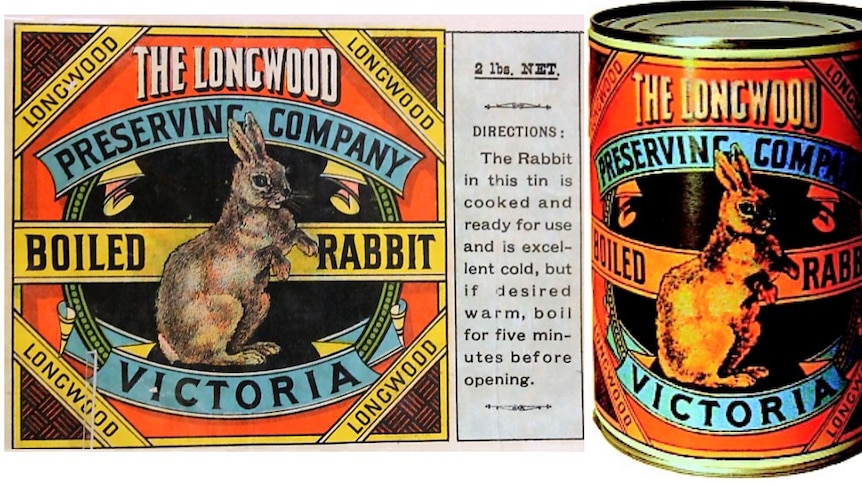
It was one of a collection of canneries operating in south-eastern Australia during the peak of the rabbit industry at the turn of the century.
Others opened at Euroa-Longwood, Port Fairy, Portland, and Colac in Victoria, at Port Augusta, Kapunda, and Eudunda in South Australia's mid north, and in the south east at Millicent and Robe — which also canned snipe and swan for export.
"The Longwood cannery was founded in 1891 where it produced rabbit for the dinner table by canning one-and-a-half jointed rabbits in a tin with brine, which was then boiled for canning and sealed with lead solder.”
Between 1870 and 1970, more than 20 billion rabbits were trapped or poisoned in South Australia and Victoria for commercial purposes.
And by the late 1920s, the rabbit industry was reported to be the largest employer in Australia.
The canned rabbit industry was sustained by military orders from Japan, the British Admiralty, and the British and Australian governments during World War I, but had largely disappeared by the 1920s.
https://www.abc.net.au/news/2024-03-04/canned-rabbit-history-in-south-eastern-australia/103532810
maximus otter

